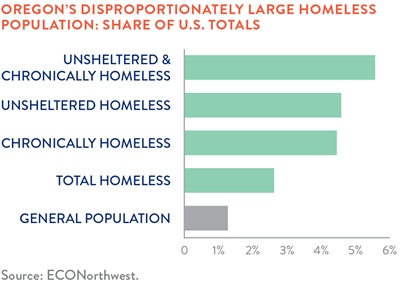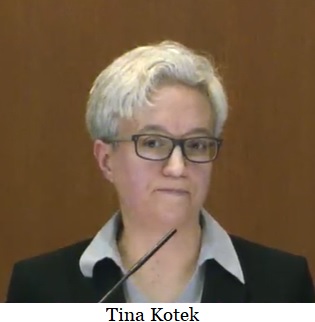Statewide homeless infrastructure results fail to keep pace with growing homelessness
Oregon Governor Tina Kotek’s first Executive Order in 2025 is to extend Emergency Order 24-02 in order to continue to address the crisis of unsheltered homelessness in Oregon.
EO 25-01 directs state agencies to continue reducing the number of people experiencing homelessness in Oregon. In tandem with other executive actions, this executive order establishes and maintains a homeless response infrastructure to address the homelessness crisis, even after the state of emergency has ended.

How well is EO 24-02 working? Homelessness has continued to increase in Oregon since January 2023 when EO 24-02 was implemented. According to the U.S. Department of Housing and Urban Development’s annual Homelessness Assessment Report, Oregon and Portland led the nation in homelessness among families in 2023, with a 13.6% increase in the number of families experiencing homelessness in one year. More recent data from the Community Services Consortium that serves Linn, Benton, and Lincoln counties shows that the counted homeless population more than doubled since 2023, with at least 1,437 people homeless in that tri-county region and 2,875 for the state.
Governor Kotek insists, “We must stay the course on what we see working. If we keep at this pace, 1 in every 3 people who were experiencing homelessness in 2023 will be rehoused. Since declaring the homelessness emergency response two years ago, we exceeded the targets we set through a statewide homelessness infrastructure we never had before. But the urgency remains as homelessness continues to increase and we need to see this strategy through.”
The Governor admits to seeing no results, but extended the emergency response to have the flexibility to sustain the system needed to reduce homelessness and determine the outcomes of the work that will continue through the end of the current biennium, which ends June 29, 2025.
“Governor Kotek came in with clear eyed recognition that the state needed to act quickly and boldly,” OHCS Executive Director Andrea Bell said. “This work is and has always been about people and making their life better. This starts with supporting and empowering local leaders to do what they do best—deliver for community. So much depends on what we, the generations now in positions of responsibility, choose to do in this moment. Building a future that includes and works for everyone is possible when we recognize the scale of our challenges and bring an even greater scale of ambition in confronting them.”
Since taking office, the Governor has taken consistent action in a socialist direction that lowers the standard of living to address homelessness in Oregon. The legislature provided her with a $155 million Homelessness Emergency Response Package of taxpayer money. Contracts were executed less than two weeks later, and dollars were disseminated shortly thereafter. That summer, the Governor signed SB 5511 into law, which included resources to continue operations established under the homelessness state of emergency and expand statewide efforts to reduce and prevent homelessness for the 2023-2025 biennium.
In spring of 2024, Governor Kotek Signed SB 1530 into law, which included additional resources to stabilize and expand existing shelters statewide and eviction and homelessness prevention services for the 2023-2025 biennium. That summer, Governor Kotek partnered with Representative Pam Marsh to convene a Sustainable Shelter Work Group with the objective of developing recommendations to establish an ongoing shelter program for the State of Oregon.
Last December, Governor Kotek released her Governor’s Recommended Budget for the 2025-2027 biennium which included the resources needed to maintain current service levels for statewide homelessness response efforts, including those established through the emergency response. Later that month, Governor Kotek received the recommendations report from the Sustainable Shelter Work Group and stated her intent to introduce an ongoing shelter program in the 2025 Legislative Session for the 2025-2027 biennium.
A D V E R T I S E M E N T

A D V E R T I S E M E N T
As a result of funding and actions taken since the initial emergency declaration in Executive Order 23-02, as of January 9, 2025, the emergency response outcomes have established 600 new low barrier shelter beds, rehoused 1,200 households experiencing unsheltered homelessness, and prevented 8,750 households from experiencing homelessness. Still homelessness continues to increase.
In addition, as of January 9, 2025, preliminary estimates indicated that the Balance of State outcomes of establishing 100 new low barrier shelter beds and rehousing 450 households experiencing unsheltered homelessness will be exceeded by the outcome deadline of June 30, 2025.
Moreover, with the broader actions taken as a part of the Governor’s statewide homelessness response effort, including the emergency response, preliminary projections indicate that by the end of the 2023-2025 biennium 5,500 shelter beds will be funded by the State of Oregon, 3,300 households will be rehoused, and 24,000 households will have been prevented from experiencing homelessness.
Taken in combination with the Governor Kotek’s Recommended Budget for the 2025-2027 biennium, if funded, the statewide homelessness response infrastructure will be established. This infrastructure will provide nearly 1 bed for every 3 people that were experiencing unsheltered homelessness when the emergency was declared in Executive Order 23-02. It is also projected that with this infrastructure, by the end of the 2025-2027 biennium over 1 in 3 people that were experiencing homelessness when the emergency was declared in Executive Order 23-02 will be rehoused – equivalent to the 16% increase in the number of people experiencing homelessness from 2017 to 2023.
However, a 16% increase over six years has accelerate to 13.6% in 2023 and continues at that pace. That is adding approximately 2,875 more homeless each year. The solutions needs more than providing shelter and homes. Oregon lacks a correction in policies to stop the increase.
--Donna Bleiler| Post Date: 2025-01-10 10:17:25 | Last Update: 2025-01-10 18:40:31 |







 How well is EO 24-02 working? Homelessness has continued to increase in Oregon since January 2023 when EO 24-02 was implemented. According to the U.S. Department of Housing and Urban Development’s annual Homelessness Assessment Report, Oregon and Portland led the nation in homelessness among families in 2023, with a 13.6% increase in the number of families experiencing homelessness in one year. More recent data from the Community Services Consortium that serves Linn, Benton, and Lincoln counties shows that the counted homeless population more than doubled since 2023, with at least 1,437 people homeless in that tri-county region and 2,875 for the state.
How well is EO 24-02 working? Homelessness has continued to increase in Oregon since January 2023 when EO 24-02 was implemented. According to the U.S. Department of Housing and Urban Development’s annual Homelessness Assessment Report, Oregon and Portland led the nation in homelessness among families in 2023, with a 13.6% increase in the number of families experiencing homelessness in one year. More recent data from the Community Services Consortium that serves Linn, Benton, and Lincoln counties shows that the counted homeless population more than doubled since 2023, with at least 1,437 people homeless in that tri-county region and 2,875 for the state.
